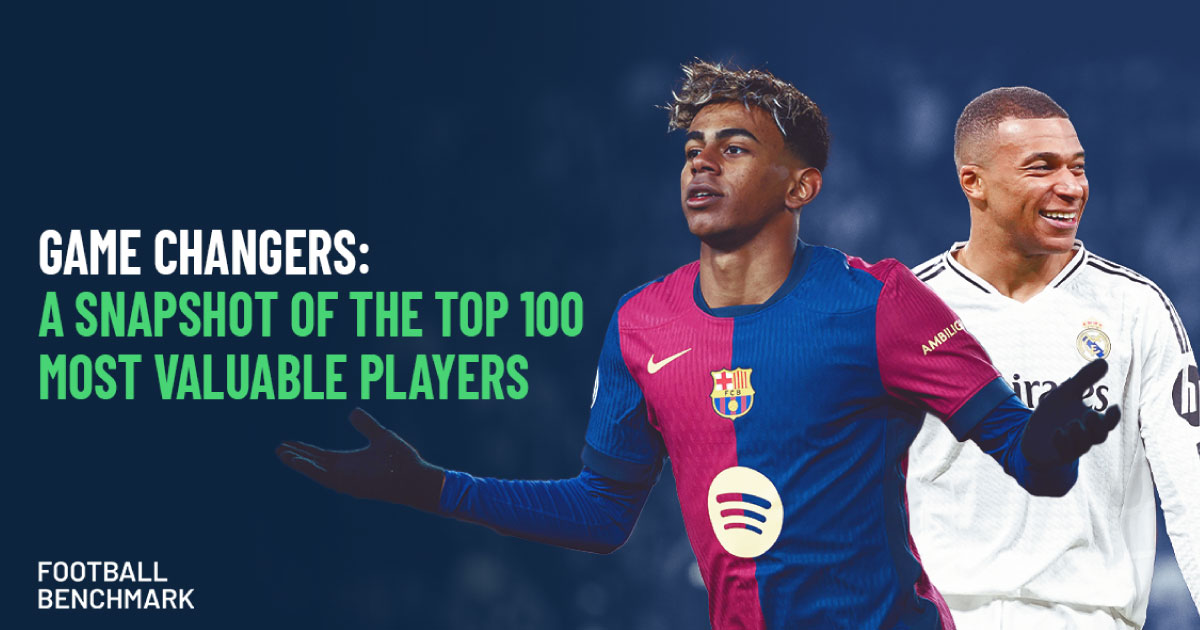
Game changers: a snapshot of the top 100 most valuable players
Following the conclusion of the winter transfer window, the latest update of the Football Benchmark Player Valuation Tool has reassessed the market value of over 10,000 players worldwide. This powerful tool, designed for clubs, agents and football governing bodies, provides an objective, data-driven valuation based on key factors such as performance metrics, contract details, age, and broader market trends. It is important to note that a player’s market valuation reflects the estimated worth of their current contracts rather than a potential transfer fee, which can be influenced by negotiations, club needs, and other external factors.
In this analysis, we take a closer look at the top 100 most valuable players as of February 2025, examining their distribution by league, club, and nationality. These players are true game changers, driving the on-pitch performance of football’s elite while also representing their clubs’ most valuable assets.
Record valuations and rise of young talents
The average market value of the top 100 currently stands at EUR 83.5m, the highest figure recorded at this stage of the season over the past seven years. Notably, 19 players surpass the EUR 100m mark, just one short of the record 20 registered in mid-season 2023/24. Kylian Mbappé remains the only player valued above EUR 200m.
The average age of football’s elite is just 23.5 years, underscoring the growing importance of youth development and the immense value young talents bring to squads. Specifically, 51 players in the top 100 are 23 or younger, while eight are aged 19 or below.
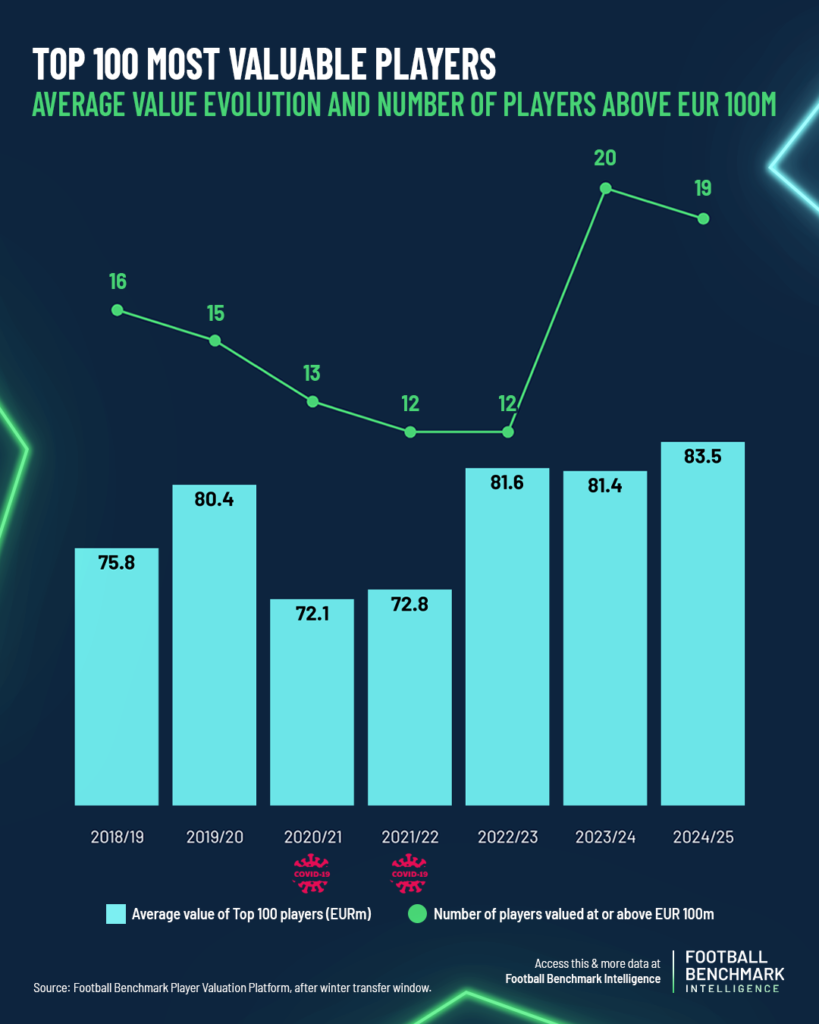
From England to Türkiye: where football’s elite talents play today?
At league level, the English Premier League dominates the rankings, with 45 players in the top 100 — more than double the number of the second-most represented league, Spain’s La Liga (20 players). The German Bundesliga follows with 13 representatives, while French Ligue 1 (9) and Italian Serie A (8) complete the “Big Five”.
Beyond these major leagues, only five players feature in the top 100: three from Portugal’s Primeira Liga (Viktor Gyökeres, António Silva, and Samu Aghehowa) and one each from the Dutch Eredivisie (Johan Bakayoko) and the Turkish Süper Lig (Victor Osimhen).
The concentration of elite talent in a handful of top leagues is becoming increasingly pronounced, making it harder for clubs outside these leagues to remain competitive internationally and reinforcing the growing imbalance of power in global football.
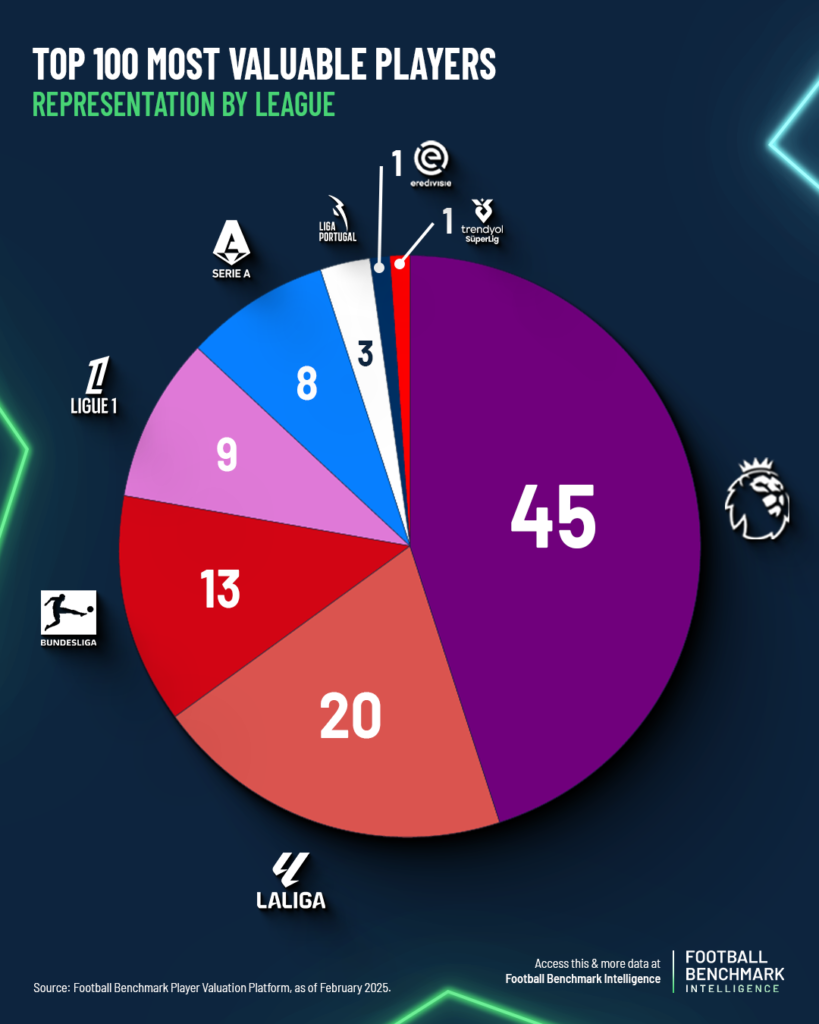
Which clubs have the strongest presence?
At club level, 27 teams feature in the top 100, with all but five coming from the “Big Five” leagues. The only exceptions are Portugal’s top three clubs (FC Porto, SL Benfica, and Sporting CP), Galatasaray SK and PSV Eindhoven. For comparison, the English Premier League has nine clubs represented.
Manchester United FC and Paris Saint-Germain FC lead the ranking, each boasting nine players. The Red Devils’ contingent is particularly youthful, with only Bruno Fernandes and Matthijs de Ligt above 23 years old. Meanwhile, PSG’s domestic dominance is evident, as all Ligue 1 players in the top 100 come from their squad. Their latest addition, Khvicha Kvaratskhelia, further strengthens their position. Les Parisiens’ most valuable players include Warren Zaïre-Emery (EUR 91.3m) and Bradley Barcola (EUR 86.6m).
Trailing closely behind are FC Barcelona, Manchester City FC, and Real Madrid CF, each with eight representatives. Notably, FC Barcelona’s Pau Cubarsí has recorded the highest valuation increase since the beginning of the season, rising by EUR 49m to reach EUR 88.8m. He is followed in this regard by Jamie Gittens of Borussia Dortmund and Omar Marmoush, recently acquired by Manchester City FC, whose values have risen by EUR 40m and EUR 34m, respectively, since September 2024.
The list of the top 10 most represented clubs is completed by four other Premier League clubs (Arsenal FC, Liverpool FC, Chelsea FC and Tottenham Hotspur FC), two Bundesliga clubs (FC Bayern Munich and Bayer 04 Leverkusen) and one Italian club (FC Internazionale). Interestingly, the Nerazzurri boast half of all Serie A players included in the top 100.
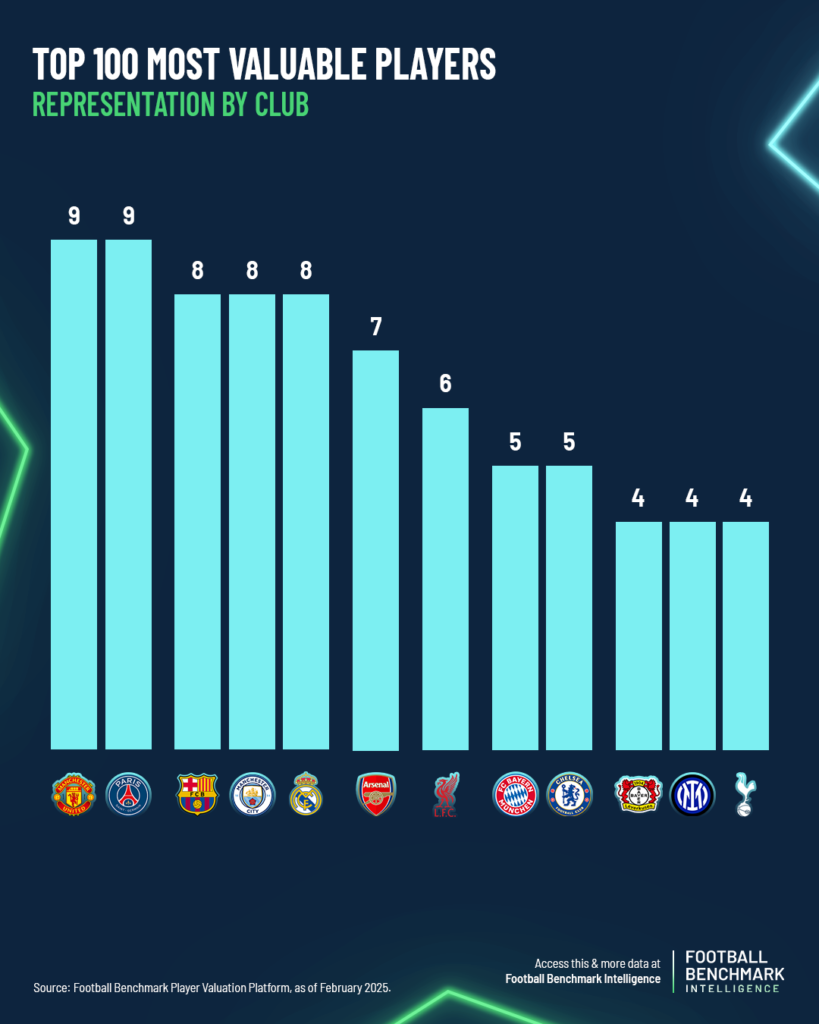
Global talent factories: nations that produce the biggest football stars
From a nationality perspective, France leads with 13 players in the top 100, although only four play in the French league. England (12 players) and Spain (10 players) follow closely. Brazil is the highest-ranking non-European nation, with eight representatives. Outside of Europe, 19 players hail from South America, while six are from Africa, and there is just one each from North America (Christian Pulisic) and Asia (Min-jae Kim).
Traditional football powerhouses Germany and Italy are underperforming in this regard, with only four representatives for Germany (Florian Wirtz, Jamal Musiala, Kai Havertz and Aleksandar Pavlovic) and three representatives for Italy (Nicolò Barella, Alessandro Bastoni and Destiny Udogie). The recent struggles of both national teams reflect this trend, with Italy missing the last two World Cups and Germany being eliminated at the group stage of the 2022 tournament.
Interestingly, there is an almost perfect alignment between the FIFA national team world rankings and the composition of the Top 10 representend countries, suggesting that player valuations can serve as a useful indication for national team performance. The same is the case with club competition success, with a correlation between squad values and progression from the initial stages of the UEFA club competitions.
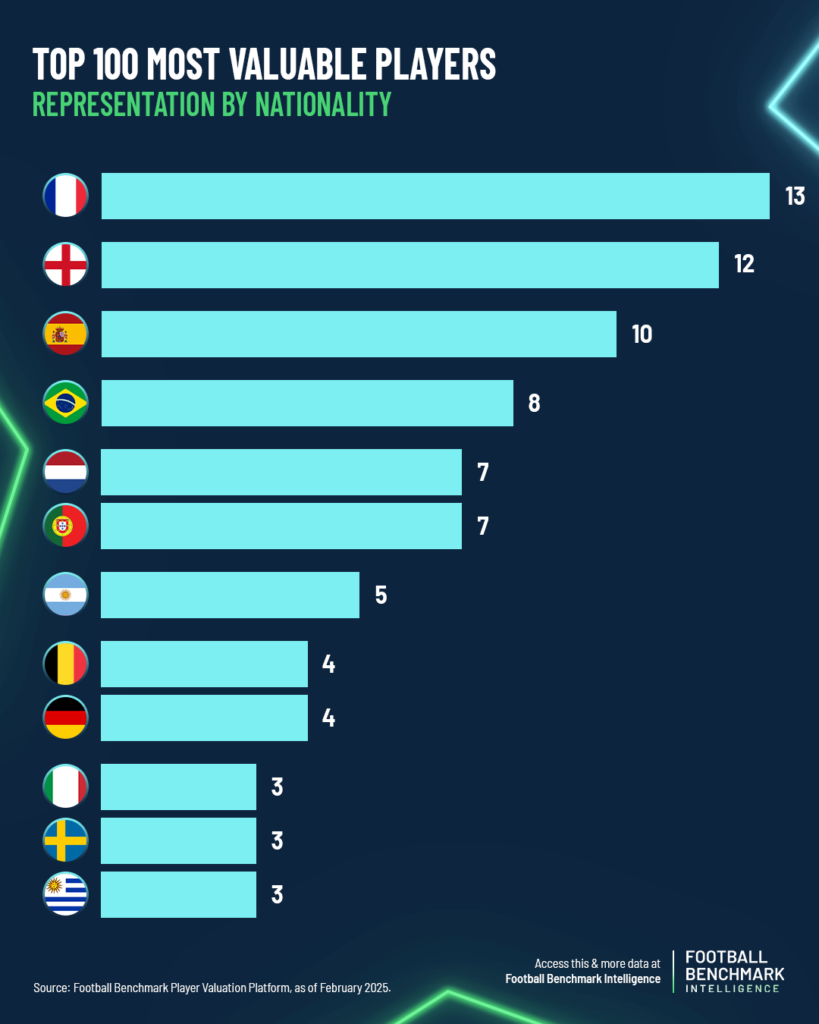
Top 10: the usual suspects
The top 10 ranking as of February 2025 has remained largely unchanged since December 2024, with the only new entry being Federico Valverde, who replaced his Real Madrid CF teammate Rodrygo in 10th place. Los Merengues continue to dominate, with four players in the Top 10, including three of the four most valuable players. Kylian Mbappé retains the top spot with a staggering valuation of EUR 229.3m, followed by Erling Haaland (EUR 188.4m) and Vinícius Júnior (EUR 186.2m), who has overtaken Jude Bellingham for a podium position.
Golden Boy winner Lamine Yamal, the youngest player in the top 100, has recorded the highest value increase within the Top 10, surging by EUR 33.6m, which propels him into 6th place. Given his rapid growth, the Blaugrana youngster is expected to break into the top 5 soon, aided by a potential contract renewal, with his current deal set to expire in 2026.
Interestingly, two players in the Top 10 have recently renewed their contracts with long-term expiration dates, highlighting top clubs’ commitment to securing their key assets. Specifically, Jamal Musiala extended his contract with FC Bayern Munich until 2030, while Erling Haaland signed a record contract extension with Manchester City FC until 2034.
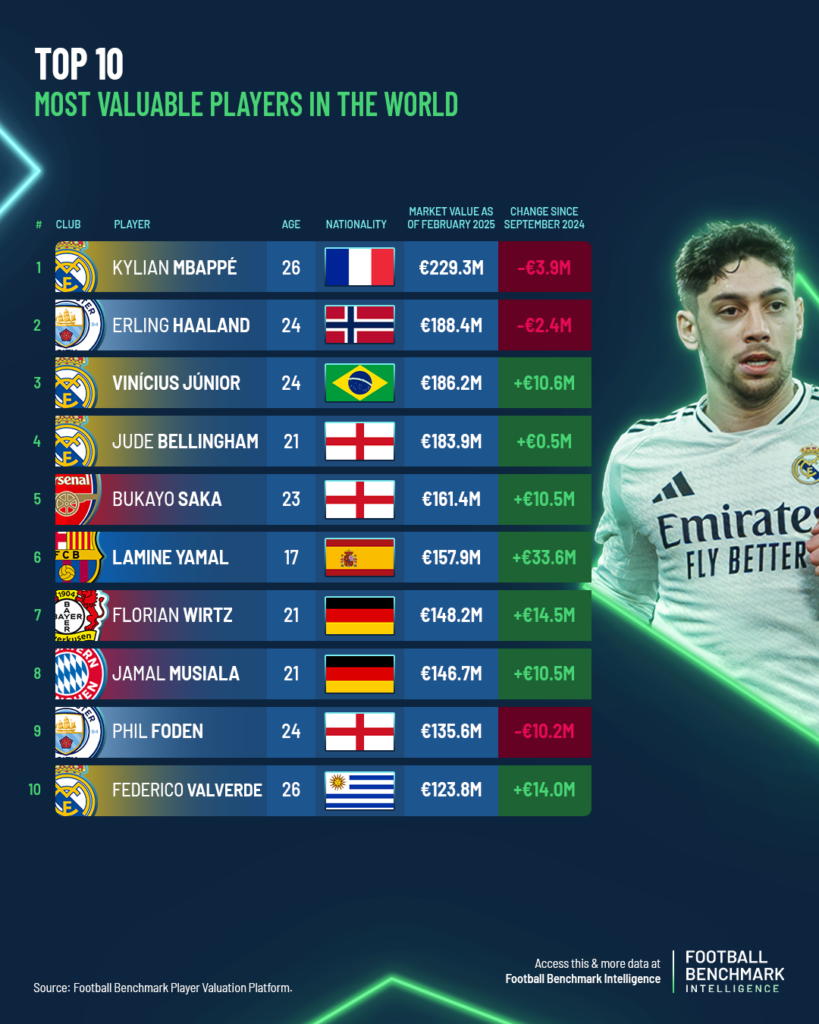
The latest update reaffirms the dominance of emerging talent in today’s football market, with no major shakeups at the top of the market value rankings. Clubs are increasingly prioritizing long-term investments in top players, while also safeguarding their assets through proactive and lengthy contract extensions. It remains to be seen how future regulatory developments following the Diarra case, analyzed in our previous article, might influence club strategies in this regard.



